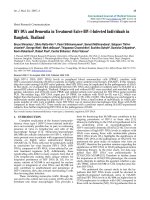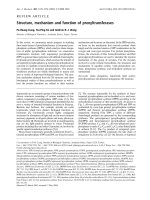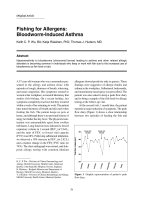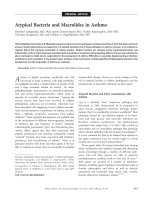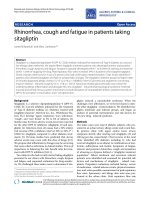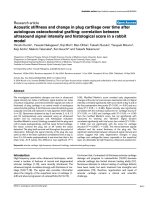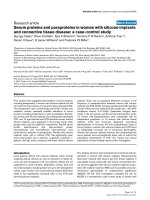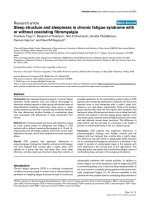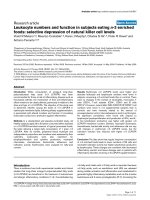Báo cáo y học: "Atypical Bacteria and Macrolides in Asthma" doc
Bạn đang xem bản rút gọn của tài liệu. Xem và tải ngay bản đầy đủ của tài liệu tại đây (148.42 KB, 6 trang )
ORIGINAL ARTICLE
Atypical Bacteria and Macrolides in Asthma
Paraskevi Xepapadaki, MD, PhD, Ioanna Koutsoumpari, MD, Vasiliki Papaevagelou, MD, PhD,
Christina Karagianni, MD, and Nikolaos G. Papadopoulos, MD, PhD
Chlamydophila pneumoniae and Mycoplasma pneumoniae are common pathogens causing acute illness in both the upper and lower
airways. Several observations are supportive of a possible causative role of these pathogens in asthma; however, more evidence is
required before this becomes meaningful in clinical practice. Atypical bacteria can enhance airway hyperresponsiveness and
inflammation, both of which have been associated with exacerbations in patients with preexisting asthma. It is less clear whether the
above mechanisms might also be responsible for the development of asthma. Difficulties in accurately diagnosing these infections
contribute to such uncertainty. In the present report, evidence of the involvement of Chlamydophila and Mycoplasma infection in the
development and the progression of asthma are reviewed.
Key words: asthma, Chlamydophila pneumoniae, Mycoplasma pneumoniae
A
sthma is highly prevalent worldwide and still
increasing in many countries, with high morbidity,
not negligible mortality, a marked effect on quality of life,
and a large economic burden on society.
1
Its major
pathophysiologic characteristics are bronchial inflamma-
tion and airway hyperresponsiveness, which result in
episodes of reversible airway obstruction.
2
Among the
various factors that have been involved in asthma
pathogenesis, infections are prominent. Infections have
been associated with triggering of acute asthma exacerba-
tions and the initiation or persistence of asthma, but also,
from a different perspective, protection from asthma
initiation.
3
These apparent discrepancies are probably due
to the involvement of different microorganisms, intensity
of infection, age, and frequency of events.
4
Similarly,
Chlamydophila pneumoniae (Cpn) and Mycoplasma pneu-
moniae (Mpn), agents that have been associated with
atypical pneumonias and therefore colloquially termed
‘‘atypical’’ bacteria, have been associated with initiation,
persistence, and exacerbations of asthma.
5
What is of
particular interest with these microbial agents is the fact
that, in contrast to viruses, they are susceptible to available
antimicrobial therapy. Herein we review evidence of the
role of atypical bacteria in asthma pathogenesis and the
potential role of macrolide antibiotics in this respect.
Atypical Bacteria and Their Associations with
Asthma
Cpn is a relatively ‘‘new’’ respiratory pathogen, first
discovered in 1986, characterized by its propensity to
cause chronic, unapparent infections. Serologic studies
indicate that it is considerably prevalent worldwide.
6
Host
immunity elicited by Cpn infection appears to be short-
lived and only partial, and recurrent infections are
therefore common. Furthermore, Cpn posttreatment
persistence rates range from 13 to 56%.
7
Mpn is both an
intracellular and an extracellular pathogen that primarily
infects ciliated epithelial cells and alveolar macrophages.
8,9
It is very common for Mpn to be isolated from sputum or
the upper respiratory tract for several weeks to several
months after recovery from clinical illness.
10
These agents infect the human bronchial tree, causing
ciliary dysfunction and epithelial damage and disturbing
airway physiology through a number of different path-
ways. Cpn and Mpn species are able to generate
proinflammatory cytokines both in vivo and in vitro.
11
Both agents are involved in a number of respiratory
diseases, including upper respiratory tract illnesses such as
rhinitis, pharyngitis, and otitis, as well as atypical
pneumonia and bronchitis, lung cancer, and, recently,
chronic obstructive pulmonary disease.
12–14
Paraskevi Xepapadaki, Ioanna Koutsoumpari, Vasiliki Papaevagelou,
Christina Karagianni, and Nikolaos G. Papadopoulos: Allergy
Department, 2nd Pediatric Clinic, University of Athens, Athens, Greece.
Correspondence to: Nikolaos G. Papadopoulos, MD, PhD, Allergy
Research Center, 41 Fidippidou str, 11527 Goudi, Greece; e-mail: ngp@
allergy.gr.
DOI 10.2310/7480.2008.00012
Allergy, Asthma, and Clinical Immunology, Vol 4, No 3 (Fall), 2008: pp 111–116 111
Atypical bacteria have been associated with airway
dysfunction in a number of ways. Infection with these
agents can induce transient wheezing in individuals with
no history of asthma.
15,16
It has also been observed that
infection with Mpn can produce long-term impairment in
airway function, even in asymptomatic children.
17
Atypical
bacteria, mostly Mpn, have been associated with acute
exacerbations of asthma in children and adults.
18,19
In
some cases, atypical bacterial infection has preceded the
onset of asthma, especially in adults,
20,21
and, more
recently, has also been suggested in children.
22
Many studies have shown a correlation between the
presence of antibodies to atypical bacteria and chronic
asthma, leading investigators to suggest a role for these
agents in the persistence of asthma or resistance to
steroids.
23
Alternatively, it is possible that chronic asth-
matic patients may be more susceptible to such infections.
However, other studies have observed no differences in
Cpn-specific antibodies between new asthma cases, estab-
lished asthma and healthy controls.
24–26
Atypical Bacteria Inducing Wheezing and/or Asthma
Exacerbations
It has been estimated that most people may have three or
more Cpn infections during their lifetime. Available
evidence supports a role for acute Cpn and Mpn
respiratory tract infections as a trigger for 5 to 30% of
wheezing episodes and/or asthma exacerbations.
27
Cpn and Mpn infections may also be accompanied by
wheezing in children considered not to have asthma.
28,29
The incidence of wheezing in acute Mpn infection was
reported to be 25 to 40% in the pediatric population.
16
Most of the studies that investigated the role of Cpn
and Mpn in acute asthma symptoms were indicative of a
positive association.
19–21,23,30–36
Hahn and colleagues were
the first to identify a consistent association between
wheezing episodes and anti-Cpn titers in patients with
acute lower respiratory illness.
20
They reported that the
proportion of patients with antibodies to Cpn was
considerably higher in those with wheezing than those
without (33% vs 17%, respectively).
20
The same authors
further extended their observations, thus showing sero-
reactivity for Cpn in 80% of patients with acute asthmatic
bronchitis compared with 53% of nonwheezing control
subjects in a dose-response manner.
21
Infection with Cpn
has been associated with 10% of acute exacerbations in
adult asthmatics.
19
In accordance, anti-C heat shock
protein IgG antibodies were significantly associated
with exacerbations but only in asthmatic adult subjects
(p , .0001).
30
However, in one of the largest studies,
undertaken in 100 adults with acute asthma exacerbations
who were compared with nonasthmatic matched control
subjects and in which immunofluorescence or enzyme
immunoassay methods were used to establish a serologic
diagnosis, only Mpn was associated with hospitalization
for asthma exacerbation (18 vs 3%, p 5 .0006 in
asthmatics and controls, respectively). No significant
differences in the rates of acute infection with Cpn,
Legionella spp, or Coxiella were noted between the two
groups.
37
Moreover, when reverse transciptase–polymerase
chain reaction (PCR) methods were used in patients
hospitalized with acute asthma and patients with stable
asthma, no atypical bacteria infection was detected, further
contributing to the controversial role of atypical bacteria
in acute asthma.
33
Other studies have also failed to
establish an association between infection with Cpn or
Mpn and severe asthma exacerbations.
35,38
Studies have also been performed in children, with the
majority showing significant correlations between infec-
tion with atypical bacteria and exacerbation of asthma
symptoms. One of the first studies, performed in more
than 100 children, indicated that Cpn infection, in terms of
positive cultures or serologic titers, was able to trigger
acute episodes of wheezing in children with asthma.
33
Moreover, the study found that treatment of Cpn infection
may improve the course of ‘‘reactive airway disease.’’
Cunningham and colleagues studied 108 children for 13
months. They showed that immune responses to Cpn
detected in 292 nasal samples taken during symptomatic
episodes were positively associated with the frequency of
asthma exacerbations.
32
Moreover, this group of children
maintained a longer PCR positivity for Cpn, suggestive of a
chronic infection. Other studies have also shown that
children with wheezing have a significantly higher
incidence of acute infection with Cpn and Mpn than
healthy controls (p 5 .01 for each pathogen).
39
The
same authors suggested a potential role for interleukin
(IL)-5 as a link between Mpn infection and acute wheez-
ing by showing higher levels of IL-5 in wheezing
children with Mpn infection than in those with asympto-
matic acute infection without wheeze.
34
However when
PCR methods were used, infection with Cpn and Mpn was
identified only in 4.5 and 2.2%, respectively, of children
hospitalized with severe asthma symptoms.
40
More
recently, Biscardi and collegues found that Mpn was
present in 20% of exacerbations in asthmatic children
requiring hospitalization, whereas 50% of children experi-
encing their first asthmatic attack were also positive for
Mpn.
22
112 Allergy, Asthma, and Clinical Immunology, Volume 4, Number 3, 2008
The high proportion of studies that have reported a
link between acute exacerbations of asthma and atypical
bacteria infection suggests that these pathogens may play a
significant role in such exacerbations. There are still
unresolved issues both with respect to microorganism
identification and study design, before an etiologic
association can be firmly established.
Atypical Bacteria at the Beginning of Asthma
Several studies have assessed the role of Cpn and Mpn
infection in the initiation of asthma symptoms, unfortu-
nately with conflicting findings. More than 15 years ago,
Hahn and colleagues reported that significantly more
patients with serologic evidence of Cpn infection devel-
oped asthmatic bronchitis in a dose-response manner.
20
Interestingly, in a cross-sectional study, subjects with late-
onset nonatopic asthma and the presence of IgG
antibodies to Cpn showed a significant decline in
postbronchodilator forced expiratory volume in 1 second
(FEV)
1
/forced vital capacity compared with subjects with-
out evidence of Cpn infection.
41
In supporting the
previous data, experimental Mpn infection in a murine
model resulted in chronic pulmonary disease characterized
by airway hyperreactivity, obstruction, and histologic
inflammation.
15
However, the aforementioned associa-
tions between Cpn infection and the increased risk of
presenting new asthma symptoms could not be verified in
other studies.
42
Studies conducted in children have also provided
inconsistent data regarding the relationship between
atypical bacteria infection and the beginning of asthma.
In a group of 119 children hospitalized for acute asthma,
62% of first-time asthmatics with seropositivity for either
Cpn or Mpn infection experienced recurrent asthma
episodes, whereas only 27% of pathogen-free patients
had a subsequent exacerbation, indicating a significant role
for these pathogens for subsequent asthma activity.
22
In
contrast, other studies failed to verify such associations
between positive Cpn serology and newly diagnosed
asthma cases, regardless of the serologic method used,
24
whereas even a possible protective role of Cpn upper
respiratory infection, in preschool- and school-aged
children, for childhood asthma has been suggested.
43
In conclusion, evidence of a causal role of Cpn or Mpn
in the initiation of asthma is inconsistent. Moreover, it
should be noted that a wheezing episode associated with a
Cpn and/or Mpn infection does not necessarily predict the
initiation of a chronic inflammatory response of the
airways, such as asthma.
Atypical Bacteria in Chronic Stable Asthma
Several studies have addressed the hypothesis that Cpn and
Mpn are implicated in the course of chronic stable asthma,
with the majority (15 of 19 studies) supporting a positive
correlation between infection with these pathogens and
asthma perpetuation.
44
Black and colleagues examined in
the context of a large multinational study the possibility
that chronic Cpn infection may lead to increased asthma
severity.
45
A positive association was found between
antibodies to Cpn and the use of high-dose inhaled
steroids and higher daytime symptom scores. It has also
been shown in adults with serologic markers indicative of
persistent Cpn infection that asthma was significantly more
common compared with normal controls.
46
In a broncho-
scopy study, an association between Cpn and Mpn,
measured by means of PCR, and stable chronic asthma
was sought; 56% of asthmatic patients had a positive PCR
for Cpn (n 5 6) or Mpn (n 5 25) compared with only one
control subject.
25
In accordance, colonization and/or
infection with Mpn have been shown to be significantly
more frequent in patients with asthma (10 of 18) than
nonasthmatic controls (1 of 11, p 5 .02).
47
To further
support a causal relationship, studies have established a
dose-responserelationshipbetweenthepresenceof
atypical bacteria and asthma. In specific, heat shock
protein 60 IgA antibodies and other serology markers
related to Cpn infection were inversely associated with
pulmonary function, as measured by FEV
1
and accordingly
associated with a higher daytime symptom score and other
markers of asthma severity.
45,48
The timing of the infection
may also play an important role in the induction of allergic
responses. The presence of Mpn infection after allergen
sensitization and challenge can increase T helper 2
inflammation and enhance mucin 5 (MUC5)gene
expression and airway hyperresponsiveness in a murine
model.
49
The same investigators also demonstrated
increased collagen deposition and elevated levels of
transforming growth factor b
1
in animal models that are
allergen challenged and subsequently infected with Mpn.
50
To what extent the atopic status may influence Cpn and
Mpn infection is still uncertain. One controlled study in
332 asthmatic subjects suggested that nonatopic indivi-
duals presented higher levels of IgG antibodies to Cpn
(odds ratio 6.0),
14
whereas, more recently, Ferrari and
colleagues showed that serologic evidence of Cpn infection
was positively associated with cough and phlegm and
possibly involved in the pathogenesis of chronic respira-
tory infection in atopic children.
51
However, in a recent
study including 104 pediatric patients with newly diag-
Xepapadaki et al, Atypical Bacteria and Macrolides in Asthma 113
nosed asthma versus 120 matched healthy controls, no
differences were found with respect to Cpn-specific
antibodies regardless of the detection method used.
24
The aforementioned evidence is supportive of a
significant correlation between Cpn and Mpn and chronic
stable asthma. Nevertheless, whether such associations
imply a causative role or an increased susceptibility of
asthmatic patients to colonization with atypical bacteria
cannot be concluded from the current evidence.
Macrolide Antibiotics
Therapy for acute asthma has remained relatively
unchanged for several years. Macrolides are not currently
included among the recommended treatments for either
acute or chronic asthma, although the initial experience
with macrolides in treating asthma dates back more than
40 years. Macrolide antibiotics have been suspected of
having beneficial effects in patients with asthma since the
1950s.
52
Several studies have shown benefits, without,
however, being conclusive enough to reach recommenda-
tions for clinical practice.
53
It has been suggested that
macrolides may act on asthma as both antimicrobials
against Mpn and Cpn and anti-inflammatory agents, a
function confirmed in several studies.
54
Ketolides are a new class of antibacterial agents, very
closely related to macrolides, showing sufficient accumula-
tion in macrophages, epithelial cells, and neutrophils,
making them suitable for the treatment of infections
caused by intracellular pathogens.
44
Immunomodulatory and Anti-inflammatory Effects
of Macrolides
Immunomodulation has been defined as suppressing
hyperimmunity and inflammation without overt immu-
nosuppression. Macrolides have been shown to decrease
bacterial adherence and virulence, biofilm formation, and
mucus hypersecretion. Only 14- and 15-membered
macrolides possess anti-inflammatory properties that
may contribute to the clinical benefits observed in patients
with airway inflammation.
55
They can modulate the
function of several inflammatory cells, such as polymor-
phonuclear leukocytes, lymphocytes, and macrophages,
although they seem to affect neutrophil migration, the
oxidative burst in phagocytes, the production of proin-
flammatory mediators (eg, tumor necrosis factor a, IL-8,
IL-6, and IL-1b), and eosinophilic inflammation.
56
The
most important molecular targets in asthma appear to be
the transcription factors activator protein 1 and nuclear
factor kB. There is also evidence that macrolides may affect
corticosteroid metabolism, thus increasing their activity
(see below).
In contradistinction, macrolides can acutely enhance
host defense by the production of inflammatory mediators
such as IL-1 by macrophages and IL-2 by lymphoid cells.
57
Clinical Trials of Macrolide Therapy in Asthma
Several studies have been conducted to evaluate the effect
of macrolides on asthmatic patients; however, only a few
are well controlled. Several years ago, Hahn was the first to
suggest that antichlamydial treatment could affect the
natural history of asthma in seroactive patients with Cpn
by means of improvement in pulmonary function
measurements and asthma symptoms.
58
Clarithromycin
has been shown to decrease methylprednisolone clearance
and increase plasma methylprednisolone levels, probably
resulting in reduced bronchial hyperresponsiveness in
adults and children with asthma.
59,60
Moreover, clarithro-
mycin suppresses bronchial hyperresponsiveness asso-
ciated with eosinophilic inflammation and potentiates
glucocorticoid responsiveness in asthmatics.
61,62
To assess the role of antibiotics in the treatment of
persistent asthma, the Chlamydia pneumoniae, Asthma
Roxithromycin multinational study, a randomized, dou-
ble-blind, placebo-controlled trial, was conducted in adult
asthmatic subjects with serologic evidence of Cpn infec-
tion.
63
The authors showed that 6 weeks of treatment with
roxithromycin resulted in significant improvement in lung
function; nevertheless, there was no improvement in asthma
symptoms. In the same context, Kraft and colleagues
demonstrated that clarithromycin, administered for 6 weeks
in adult asthmatics, elicited an increase in FEV
1
and a
decrease in the bronchial expression of IL-5, but only in
patients with PCR-documented atypical infection.
64
Overall,
a systematic review of macrolide use on stable chronic
asthma showed a positive effect on clinical symptoms and
markers of eosinophilic inflammation but concluded that
further studies will be required for confirmation.
65
With respect to acute asthma, a recent multicenter,
double-blind, randomized, placebo-controlled study
assessed the efficacy of oral telithromycin for 10 days as
a supplement to standard treatment for patients with an
acute asthma exacerbation. Patients in the treatment group
showed significant improvements in both symptoms and
lung function, suggesting that this treatment may provide
some benefit. The effect did not seem to crucially depend
on the presence of atypical bacteria, although this was not
conclusive.
66
Therefore, further workup is essential to
114 Allergy, Asthma, and Clinical Immunology, Volume 4, Number 3, 2008
identify patient groups most likely to benefit from new
treatment approaches in asthma exacerbations.
67
Studies in children have also shown positive effects of
antichlamydial treatment in asthma-related symptoms.
Clarithromycin administration significantly reduced the
duration and the risk of subsequent wheezing episodes in
children with evidence of Mpn and Cpn infection
compared with placebo.
68
Conclusions
There is increasing evidence that infection with atypical
pathogens may play a important role in the induction of
asthma symptoms in the context of chronic persistent
asthma or asthma exacerbations. Whether Cpn and Mpn
infection or airway localization indicate an increased
susceptibility to infection leading to increased frequency
of detection or whether these organisms play a more direct
role in the pathogenesis of asthma, acutely or chronically,
is not fully resolved. There is a clear requirement for
standardization in detection methods for atypical patho-
gens. In addition, well-controlled research is urgently
required to further estimate the clinical benefit of
antibiotic treatment in asthmatic patients.
References
1. Asher MI, Montefort S, Bjorksten B, et al. Worldwide time trends
in the prevalence of symptoms of asthma, allergic rhinoconjuncti-
vitis, and eczema in childhood: ISAAC Phases One and Three
repeat multicountry cross-sectional surveys. Lancet 2006;368:733–
43.
2. Bousquet J, Clark TJ, Hurd S, et al. GINA guidelines on asthma
and beyond. Allergy 2007;62:102–12.
3. Martinez FD. Genes, environments, development and asthma: a
reappraisal. Eur Respir J 2007;29:179–84.
4. Xepapadaki P, Papadopoulos NG. Viral infections and allergies.
Immunobiology 2007;212:453–9.
5. Nisar N, Guleria R, Kumar S, et al. Mycoplasma pneumoniae and
its role in asthma. Postgrad Med J 2007;83:100–4.
6. Grayston JT, Kuo CC, Wang SP, Altman J. A new Chlamydia
psittaci strain, TWAR, isolated in acute respiratory tract infections.
N Engl J Med 1986;315:161–8.
7. Harris JA, Kolokathis A, Campbell M, et al. Safety and efficacy of
azithromycin in the treatment of community-acquired pneumonia
in children. Pediatr Infect Dis J 1998;17:865–71.
8. Peeling RW, Brunham RC. Chlamydiae as pathogens: new species
and new issues. Emerg Infect Dis 1996;2:307–19.
9. Hammerschlag MR. The intracellular life of chlamydiae. Semin
Pediatr Infect Dis 2002;13:239–48.
10. Blasi F. Atypical pathogens and respiratory tract infections. Eur
Respir J 2004;24:171–81.
11. Martin RJ. Infections and asthma. Clin Chest Med 2006;27:87–98,
vi.
12. Littman AJ, Jackson LA, Vaughan TL. Chlamydia pneumoniae and
lung cancer: epidemiologic evidence. Cancer Epidemiol
Biomarkers Prev 2005;14:773–8.
13. Tsolia MN, Psarras S, Bossios A, et al. Etiology of community-
acquired pneumonia in hospitalized school-age children: evidence
for high prevalence of viral infections. Clin Infect Dis 2004;39:681–
6.
14. vonHertzenL,IsoahoR,LeinonenM,etal.Chlamydia
pneumoniae antibodies in chronic obstructive pulmonary disease.
Int J Epidemiol 1996;25:658–64.
15. Hardy RD, Jafri HS, Olsen K, et al. Mycoplasma pneumoniae
induces chronic respiratory infection, airway hyperreactivity, and
pulmonary inflammation: a murine model of infection-associated
chronic reactive airway disease. Infect Immun 2002;70:649–54.
16. Principi N, Esposito S. Mycoplasma pneumoniae and Chlamydia
pneumoniae cause lower respiratory tract disease in paediatric
patients. Curr Opin Infect Dis 2002;15:295–300.
17. Katz B, Waites K. Emerging intracellular bacterial infections. Clin
Lab Med 2004;24:627–49, vi.
18. Johnston SL, Pattemore PK, Sanderson G, et al. Community study
of role of viral infections in exacerbations of asthma in 9-11 year
old children. BMJ 1995;310:1225–9.
19. Allegra L, Blasi F, Centanni S, et al. Acute exacerbations of asthma
in adults: role of Chlamydia pneumoniae infection. Eur Respir J
1994;7:2165–8.
20. Hahn DL, Dodge RW, Golubjatnikov R. Association of Chlamydia
pneumoniae (strain TWAR) infection with wheezing, asthmatic
bronchitis, and adult-onset asthma. JAMA 1991;266:225–30.
21. Hahn DL, Golubjatnikov R. Asthma and chlamydial infection: a
case series. J Fam Pract 1994;38:589–95.
22. Biscardi S, Lorrot M, Marc E, et al. Mycoplasma pneumoniae and
asthma in children. Clin Infect Dis 2004;38:1341–6.
23. Thumerelle C, Deschildre A, Bouquillon C, et al. Role of viruses
and atypical bacteria in exacerbations of asthma in hospitalized
children: a prospective study in the Nord-Pas de Calais region
(France). Pediatr Pulmonol 2003;35:75–82.
24. Korppi M, Paldanius M, Hyvarinen A, et al. Chlamydia
pneumoniae and newly diagnosed asthma: a case-control study
in 1 to 6-year-old children. Respirology 2004;9:255–9.
25. Martin RJ, Kraft M, Chu HW, et al. A link between chronic asthma
and chronic infection. J Allergy Clin Immunol 2001;107:595–601.
26. Tuuminen T, Edelstein I, Punin A, et al. Use of quantitative and
objective enzyme immunoassays to investigate the possible
association between Chlamydia pneumoniae and Mycoplasma
pneumoniae antibodies and asthma. Clin Microbiol Infect 2004;10:
345–8.
27. Gern JE, Lemanske RF Jr. Infectious triggers of pediatric asthma.
Pediatr Clin North Am 2003;50:555–75, vi.
28. Gendrel D, Raymond J, Moulin F, et al. Etiology and response to
antibiotic therapy of community-acquired pneumonia in French
children. Eur J Clin Microbiol Infect Dis 1997;16:388–91.
29. Principi N, Esposito S, Blasi F, Allegra L. Role of Mycoplasma
pneumoniae and Chlamydia pneumoniae in children with
community-acquired lower respiratory tract infections. Clin
Infect Dis 2001;32:1281–9.
30. Betsou F, Sueur JM, Orfila J. Anti-Chlamydia pneumoniae heat
shock protein 10 antibodies in asthmatic adults. FEMS Immunol
Med Microbiol 2003;35:107–11.
Xepapadaki et al, Atypical Bacteria and Macrolides in Asthma 115
31. Cook PJ, Davies P, Tunnicliffe W, et al. Chlamydia pneumoniae
and asthma. Thorax 1998;53:254–9.
32. Cunningham AF, Johnston SL, Julious SA, et al. Chronic
Chlamydia pneumoniae infection and asthma exacerbations in
children. Eur Respir J 1998;11:345–9.
33. Emre U, Roblin PM, Gelling M, et al. The association of
Chlamydia pneumoniae infection and reactive airway disease in
children. Arch Pediatr Adolesc Med 1994;148:727–32.
34. Esposito S, Droghetti R, Bosis S, et al. Cytokine secretion in
children with acute Mycoplasma pneumoniae infection and
wheeze. Pediatr Pulmonol 2002;34:122–7.
35. Meloni F, Paschetto E, Mangiarotti P, et al. Acute Chlamydia
pneumoniae and Mycoplasma pneumoniae infections in commu-
nity-acquired pneumonia and exacerbations of COPD or asthma:
therapeutic considerations. J Chemother 2004;16:70–6.
36. Miyashita N, Kubota Y, Nakajima M, et al. Chlamydia pneumo-
niae and exacerbations of asthma in adults. Ann Allergy Asthma
Immunol 1998;80:405–9.
37. Lieberman D, Printz S, Ben-Yaakov M, et al. Atypical pathogen
infection in adults with acute exacerbation of bronchial asthma.
Am J Respir Crit Care Med 2003;167:406–10.
38. Green RM, Custovic A, Sanderson G, et al. Synergism between
allergens and viruses and risk of hospital admission with asthma:
case-control study. BMJ 2002;324:763.
39. Esposito S, Blasi F, Arosio C, et al. Importance of acute
Mycoplasma pneumoniae and Chlamydia pneumoniae infections
in children with wheezing. Eur Respir J 2000;16:1142–6.
40. Freymuth F, Vabret A, Brouard J, et al. Detection of viral,
Chlamydia pneumoniae and Mycoplasma pneumoniae infections
in exacerbations of asthma in children. J Clin Virol 1999;13:131–9.
41. ten Brinke A, van Dissel JT, Sterk PJ, et al. Persistent airflow
limitation in adult-onset nonatopic asthma is associated with
serologic evidence of Chlamydia pneumoniae infection. J Allergy
Clin Immunol 2001;107:449–54.
42. Pasternack R, Huhtala H, Karjalainen J. Chlamydophila
(Chlamydia) pneumoniae serology and asthma in adults: a
longitudinal analysis. J Allergy Clin Immunol 2005;116:1123–8.
43. Schmidt SM, Muller CE, Wiersbitzky SK. Inverse association
between Chlamydia pneumoniae respiratory tract infection and
initiation of asthma or allergic rhinitis in children. Pediatr Allergy
Immunol 2005;16:137–44.
44. Johnston SL, Martin RJ. Chlamydophila pneumoniae and
Mycoplasma pneumoniae: a role in asthma pathogenesis? Am J
Respir Crit Care Med 2005;172:1078–89.
45. Black PN, Scicchitano R, Jenkins CR, et al. Serological evidence of
infection with Chlamydia pneumoniae is related to the severity of
asthma. Eur Respir J 2000;15:254–9.
46. Falck G, Gnarpe J, Hansson LO, et al. Comparison of individuals
with and without specific IgA antibodies to Chlamydia pneumo-
niae: respiratory morbidity and the metabolic syndrome. Chest
2002;122:1587–93.
47. Kraft M, Cassell GH, Henson JE, et al. Detection of Mycoplasma
pneumoniae in the airways of adults with chronic asthma. Am J
Respir Crit Care Med 1998;158:998–1001.
48. Huittinen T, Hahn D, Anttila T, et al. Host immune response to
Chlamydia pneumoniae heat shock protein 60 is associated with
asthma. Eur Respir J 2001;17:1078–82.
49. Chu HW, Honour JM, Rawlinson CA, et al. Effects of respiratory
Mycoplasma pneumoniae infection on allergen-induced bronchial
hyperresponsiveness and lung inflammation in mice. Infect
Immun 2003;71:1520–6.
50. Chu HW, Rino JG, Wexler RB, et al. Mycoplasma pneumoniae
infection increases airway collagen deposition in a murine model
of allergic airway inflammation. Am J Physiol Lung Cell Mol
Physiol 2005;289:L125–33.
51. Ferrari M, Poli A, Olivieri M, et al. Respiratory symptoms, asthma,
atopy and Chlamydia pneumoniae IgG antibodies in a general
population sample of young adults. Infection 2002;30:203–7.
52. Kaplan MA, Goldin M. The use of triacetyloleandomycin in
chronic infectious asthma. Antibiot Annu 1958;6:273–6.
53. Hirschmann JV. Antibiotics for common respiratory tract
infections in adults. Arch Intern Med 2002;162:256–64.
54. Blasi F, Johnston SL. The role of antibiotics in asthma. Int J
Antimicrob Agents 2007;29:485–93.
55. Shinkai M, Rubin BK. Macrolides and airway inflammation in
children. Paediatr Respir Rev 2005;6:227–35.
56. Gotfried MH. Macrolides for the treatment of chronic sinusitis,
asthma, and COPD. Chest 2004;125:52S–60S; quiz S–1S.
57. Shinkai M, Foster GH, Rubin BK. Macrolide antibiotics modulate
ERK phosphorylation and IL-8 and GM-CSF production by
human bronchial epithelial cells. Am J Physiol Lung Cell Mol
Physiol 2006;290:L75–85.
58. Hahn DL. Treatment of Chlamydia pneumoniae infection in adult
asthma: a before-after trial. J Fam Pract 1995;41:345–51.
59. Kostadima E, Tsiodras S, Alexopoulos EI, et al. Clarithromycin
reduces the severity of bronchial hyperresponsiveness in patients
with asthma. Eur Respir J 2004;23:714–7.
60. Fost DA, Leung DY, Martin RJ, et al. Inhibition of methylpredni-
solone elimination in the presence of clarithromycin therapy. J
Allergy Clin Immunol 1999;103:1031–5.
61. Amayasu H, Yoshida S, Ebana S, et al. Clarithromycin suppresses
bronchial hyperresponsiveness associated with eosinophilic inflam-
mation in patients with asthma. Ann Allergy Asthma Immunol
2000;84:594–8.
62. Spahn JD, Fost DA, Covar R, et al. Clarithromycin potentiates
glucocorticoid responsiveness in patients with asthma: results of a
pilot study. Ann Allergy Asthma Immunol 2001;87:501–5.
63. Black PN, Blasi F, Jenkins CR, et al. Trial of roxithromycin in
subjects with asthma and serological evidence of infection with
Chlamydia pneumoniae. Am J Respir Crit Care Med 2001;164:
536–41.
64. Kraft M, Cassell GH, Pak J, Martin RJ. Mycoplasma pneumoniae
and Chlamydia pneumoniae in asthma: effect of clarithromycin.
Chest 2002;121:1782–8.
65. Richeldi L, Ferrara G, Fabbri LM, et al. Macrolides for chronic
asthma. Cochrane Database Syst Rev 2005;4:CD002997.
66. Johnston SL, Blasi F, Black PN, et al. The effect of telithromycin in
acute exacerbations of asthma. N Engl J Med 2006;354:1589–600.
67. Little FF. Treating acute asthma with antibiotics—not quite yet. N
Engl J Med 2006;354:1632–4.
68. Esposito S, Blasi F, Bosis F, et al. Efficacy of clarithromycin for the
treatment of acute episodes of bronchospasm in children with a
history of recurrent wheezing. 22nd annual meeting of European
Society for Pediatric Infectious Diseases (ESPID). Tampere,
Finland, 2004.
116 Allergy, Asthma, and Clinical Immunology, Volume 4, Number 3, 2008
